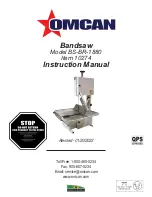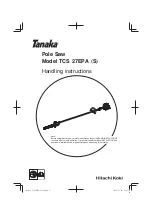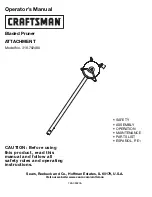
22 ENGLISH
Removing and installing saw blade
WARNING:
Always be sure that the tool is
switched off and unplugged before installing or
removing the blade.
Accidental start up of the tool
may result in serious personal injury.
WARNING:
Use only the Makita wrench pro
-
vided to install or remove the blade.
Failure to use
the wrench may result in overtightening or insufficient
tightening of the hex socket bolt and serious personal
injury.
Always lock the carriage with raised position when
removing and installing the blade. Pull the stopper pin
and rotate it 90° with the carriage raised.
►
Fig.29:
1.
Unlocked position
2.
Locked position
3.
Stopper pin
Removing the blade
Loosen the hex bolt holding the center cover using the
hex wrench. Raise the blade guard and center cover.
►
Fig.30:
1.
Center cover
2.
Hex wrench
3.
Blade
guard
Press the shaft lock to lock the spindle and use the hex
wrench to loosen the hex socket bolt. Then remove the
hex socket bolt, outer flange and blade.
►
Fig.31:
1.
Shaft lock
2.
Hex wrench
3.
Hex socket
bolt (left-handed)
4.
Loosen
5.
Tighten
Installing the blade
Mount the blade carefully onto the spindle, making
sure that the direction of the arrow on the surface of the
blade matches the direction of the arrow on the blade
case.
►
Fig.32:
1.
Arrow on the blade case
2.
Arrow on the
blade
Install the outer flange and hex socket bolt. Tighten the
hex socket bolt counterclockwise using the hex wrench
while pressing the shaft lock.
►
Fig.33:
1.
Hex socket bolt
2.
Outer flange
3.
Saw
blade
4.
Inner flange
5.
Spindle
6.
Ring
NOTICE:
If the inner flange is removed, be sure to
install it on the spindle with its protrusion facing away
from the blade. If the flange is installed incorrectly, the
flange will rub against the machine.
Return the blade guard and center cover to its original
position. Then tighten the hex bolt clockwise to secure
the center cover. Unlock the stopper pin to release
carriage from the raised position. Lower the handle to
make sure that the blade guard moves properly. Make
sure shaft lock has released spindle before making cut.
WARNING:
Before mounting the blade onto
the spindle, always be sure that the correct ring
for the blade's arbor hole you intend to use is
installed between the inner and the outer flanges.
Use of the incorrect arbor hole ring may result in the
improper mounting of the blade causing blade move-
ment and severe vibration resulting in possible loss
of control during operation and in serious personal
injury.
Connecting a vacuum cleaner
When you wish to perform clean cutting operation, con-
nect a Makita vacuum cleaner to the dust nozzle using
a front cuff 24 (optional accessory).
►
Fig.34:
1.
Front cuff 24
2.
Hose
3.
Vacuum cleaner
Dust bag
The use of the dust bag makes cutting operations clean and
dust collection easy. To attach the dust bag, remove the
dust extraction hose on the tool and connect the dust bag.
►
Fig.35:
1.
Dust extraction hose
2.
Dust bag
When the dust bag is about half full, remove the dust
bag from the tool and pull the fastener out. Empty
the dust bag of its contents, tapping it lightly so as to
remove particles adhering to the insides which might
hamper further collection.
►
Fig.36:
1.
Fastener
Securing workpiece
WARNING:
It is extremely important to always
secure the workpiece correctly with the proper
type of vise or crown molding stoppers.
Failure to
do so may result in serious personal injury and cause
damage to the tool and/or the workpiece.
WARNING:
After a cutting operation do not
raise the blade until it has come to a complete
stop.
The raising of a coasting blade may result in
serious personal injury and damage to the workpiece.
WARNING:
When cutting a workpiece that
is longer than the support base of the saw, the
material should be supported the entire length
beyond the support base and at the same height
to keep the material level.
Proper workpiece support
will help avoid blade pinch and possible kickback
which may result in serious personal injury. Do not
rely solely on the vertical vise and/or horizontal vise
to secure the workpiece. Thin material tends to sag.
Support workpiece over its entire length to avoid
blade pinch and possible KICKBACK.
►
Fig.37:
1.
Support
2.
Turn base
Guide fences
WARNING:
Before operating the tool, make
sure that the upper fence is secured firmly.
WARNING:
Before bevel-cutting, make sure
that no part of the tool, especially the blade, con
-
tacts the upper and lower fences when fully low
-
ering and raising the handle in any position and
while moving the carriage through its full range
of travel.
If the tool or blade makes contact with
the fence this may result in kickback or unexpected
movement of the material and serious personal injury.
Use upper fences to support the material higher than
the lower fences. Insert the upper fence into the hole on
the lower fence and tighten the clamping screw.
►
Fig.38:
1.
Upper fence
2.
Lower fence
3.
Clamping
screw
4.
Adjusting screw
Summary of Contents for 122088
Page 2: ...Fig 1 10 11 12 14 15 3 2 4 5 8 7 9 13 6 1 16 17 18 19 20 21 Fig 2 2 ...
Page 3: ...7 8 5 6 1 2 3 4 9 10 11 15 13 12 14 Fig 3 1 2 Fig 4 1 3 2 4 Fig 5 3 ...
Page 4: ...1 3 2 Fig 6 1 Fig 7 1 Fig 8 3 1 2 Fig 9 1 Fig 10 1 2 3 4 6 5 Fig 11 4 ...
Page 5: ...1 Fig 12 1 Fig 13 1 3 2 Fig 14 1 2 Fig 15 1 3 2 4 Fig 16 1 Fig 17 5 ...
Page 6: ...1 Fig 18 1 2 Fig 19 1 Fig 20 1 Fig 21 1 Fig 22 3 2 1 Fig 23 1 2 3 Fig 24 6 ...
Page 7: ...1 Fig 25 1 Fig 26 A B Fig 27 1 Fig 28 3 1 2 Fig 29 7 ...
Page 8: ...3 1 2 Fig 30 2 3 1 4 5 Fig 31 1 2 Fig 32 1 2 3 4 5 6 Fig 33 3 1 2 Fig 34 8 ...
Page 9: ...1 2 Fig 35 1 Fig 36 1 2 Fig 37 1 2 4 3 2 1 3 4 Fig 38 2 3 1 Fig 39 1 2 3 4 Fig 40 9 ...
Page 10: ...1 2 3 Fig 41 2 1 Fig 42 1 Fig 43 1 Fig 44 Fig 45 10 ...
Page 11: ...1 2 3 Fig 46 1 2 3 Fig 47 2 3 1 4 Fig 48 1 2 3 4 Fig 49 1 4 2 3 Fig 50 2 1 Fig 51 11 ...
Page 13: ...1 Fig 60 2 1 Fig 61 1 2 3 Fig 62 Fig 63 1 2 Fig 64 13 ...
Page 14: ...4 5 1 3 2 Fig 65 1 4 2 3 5 Fig 66 1 2 Fig 67 1 Fig 68 1 Fig 69 14 ...
















































